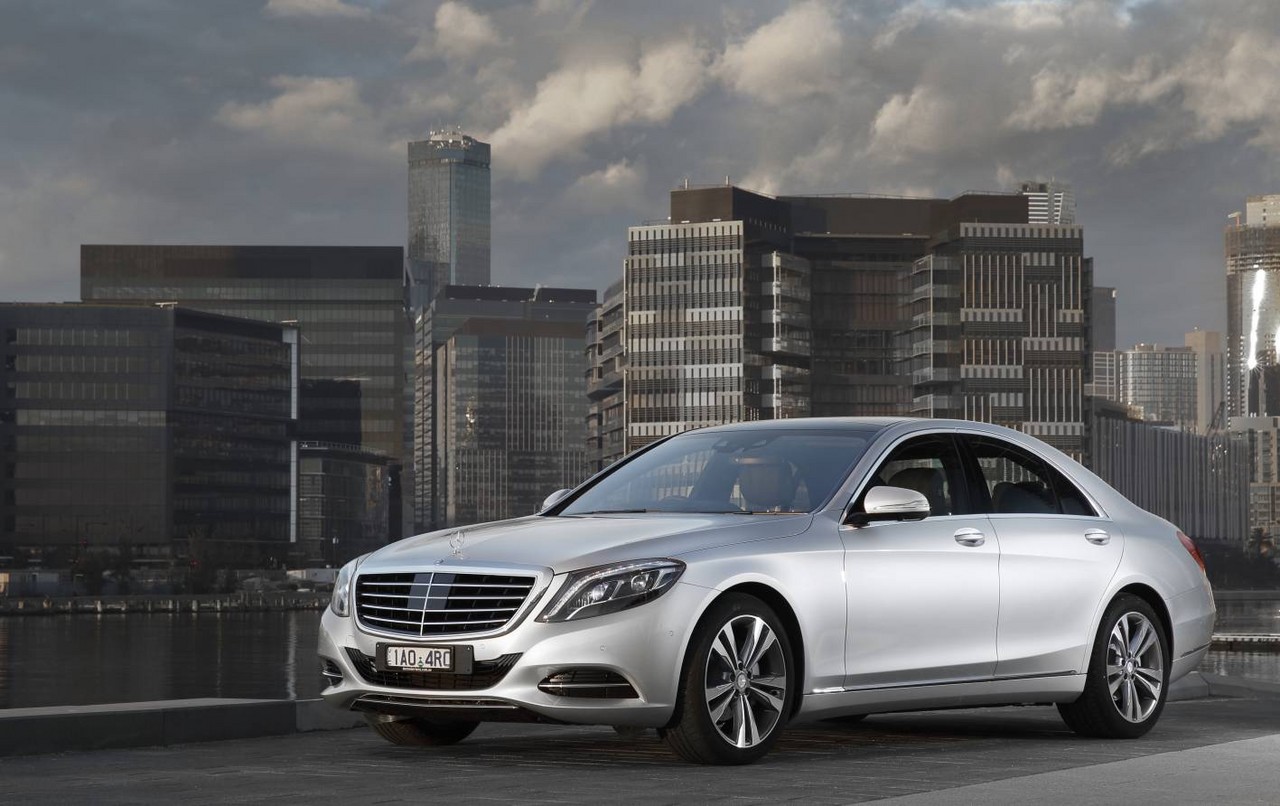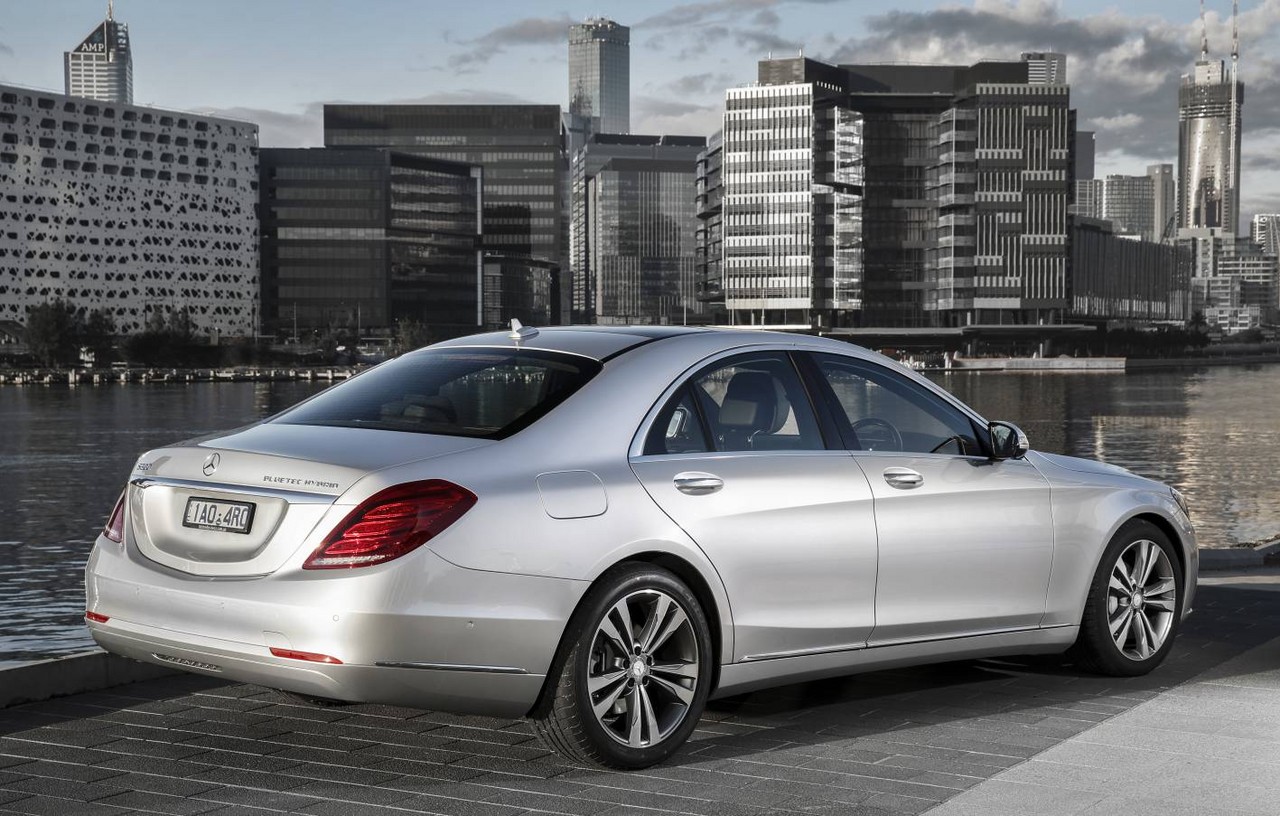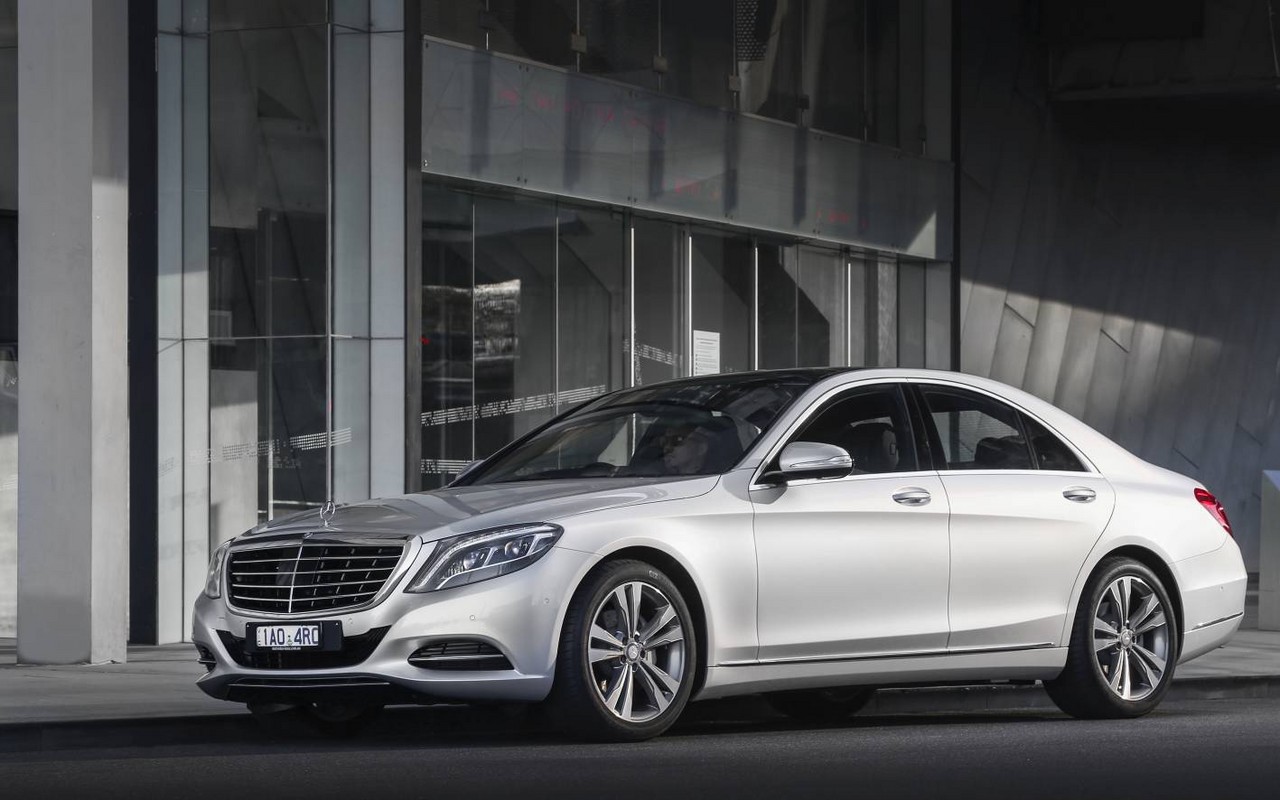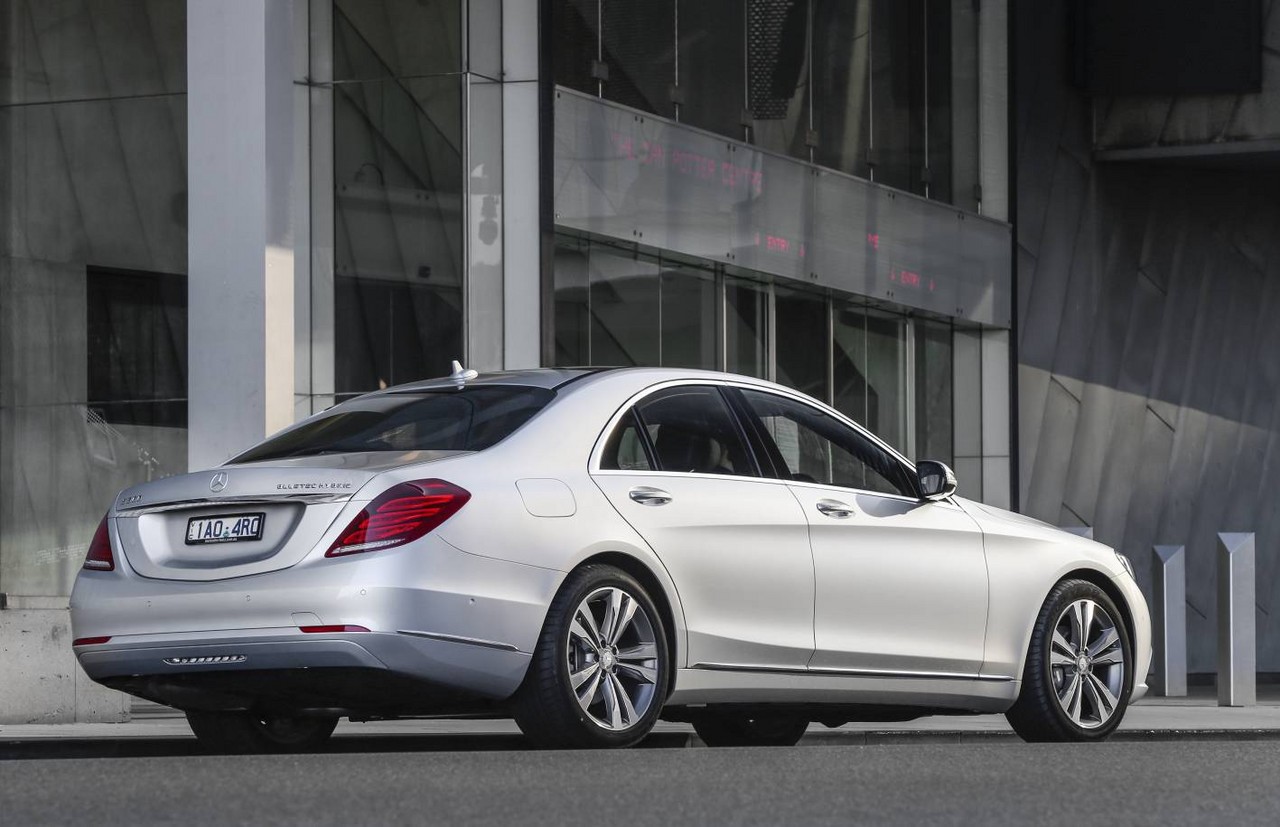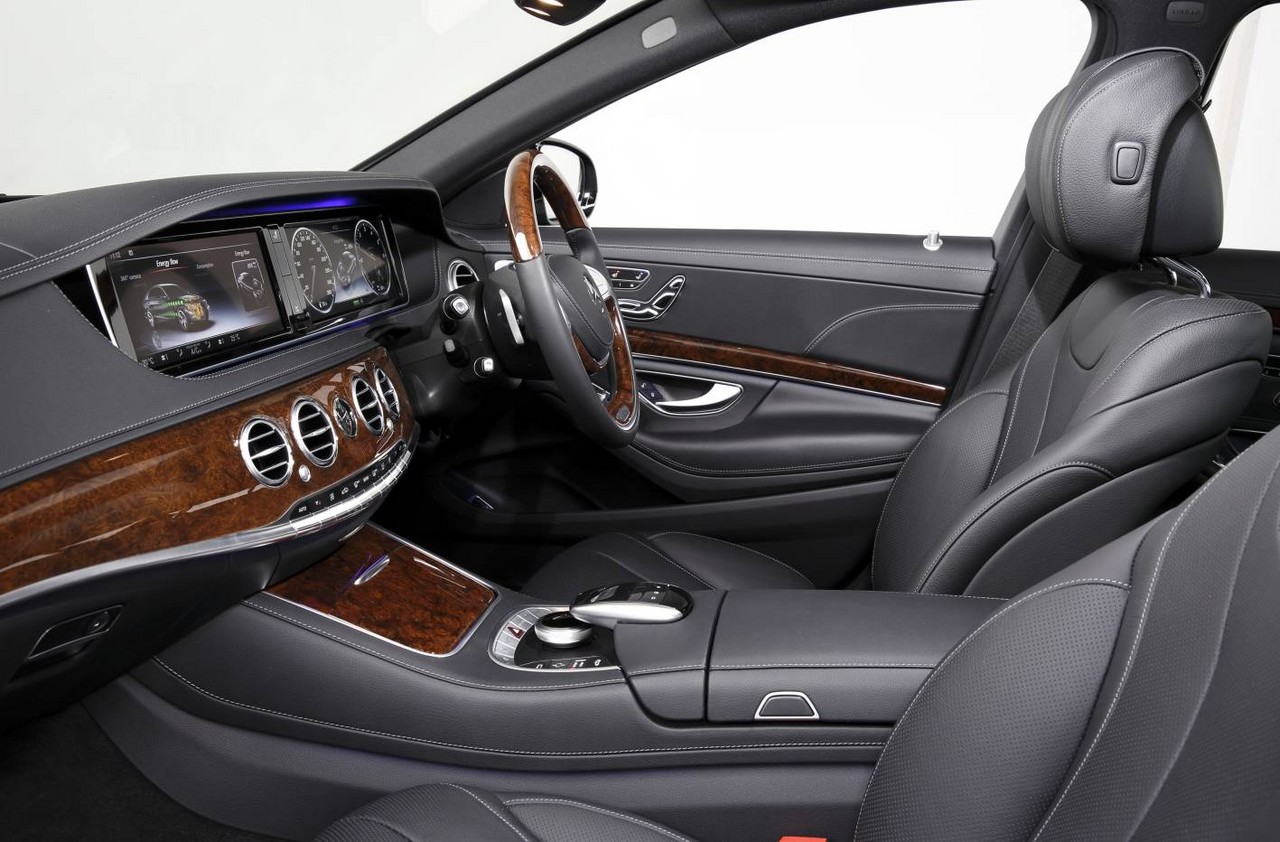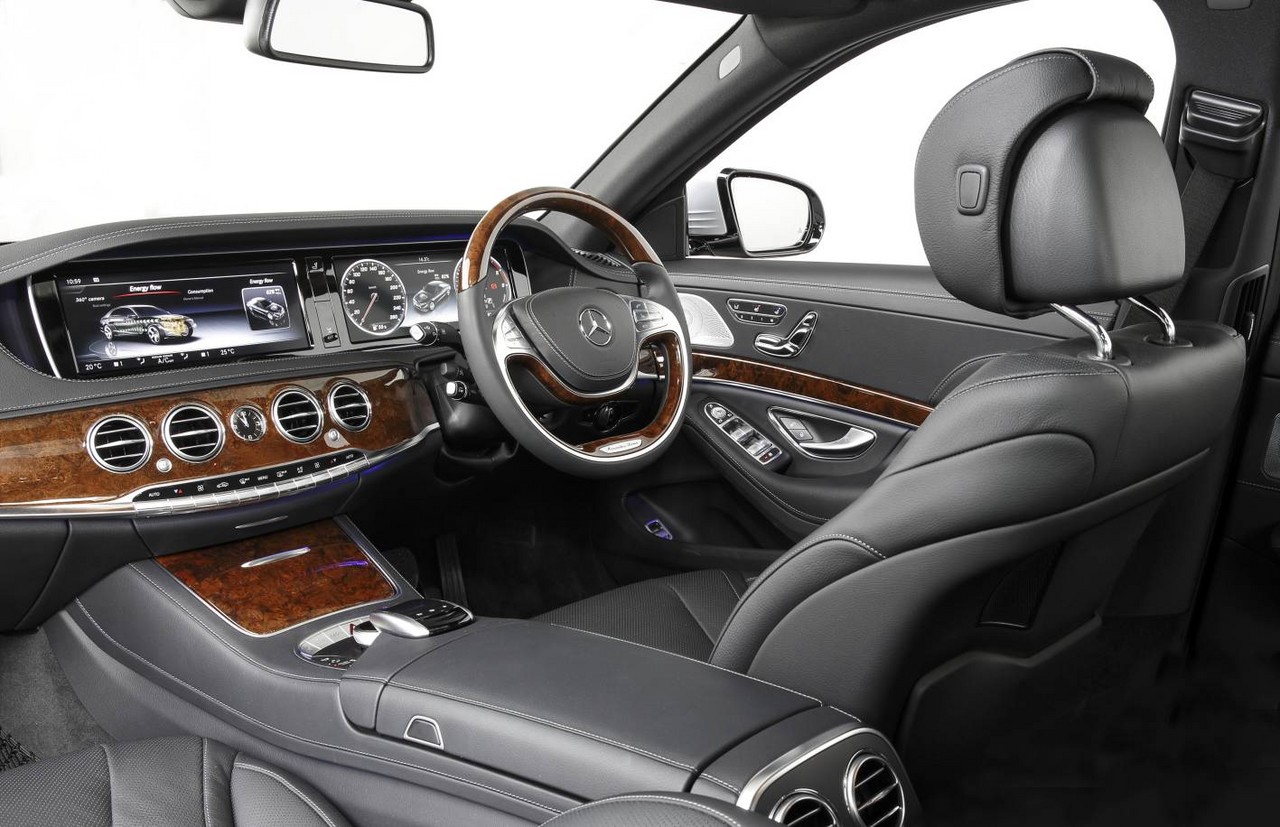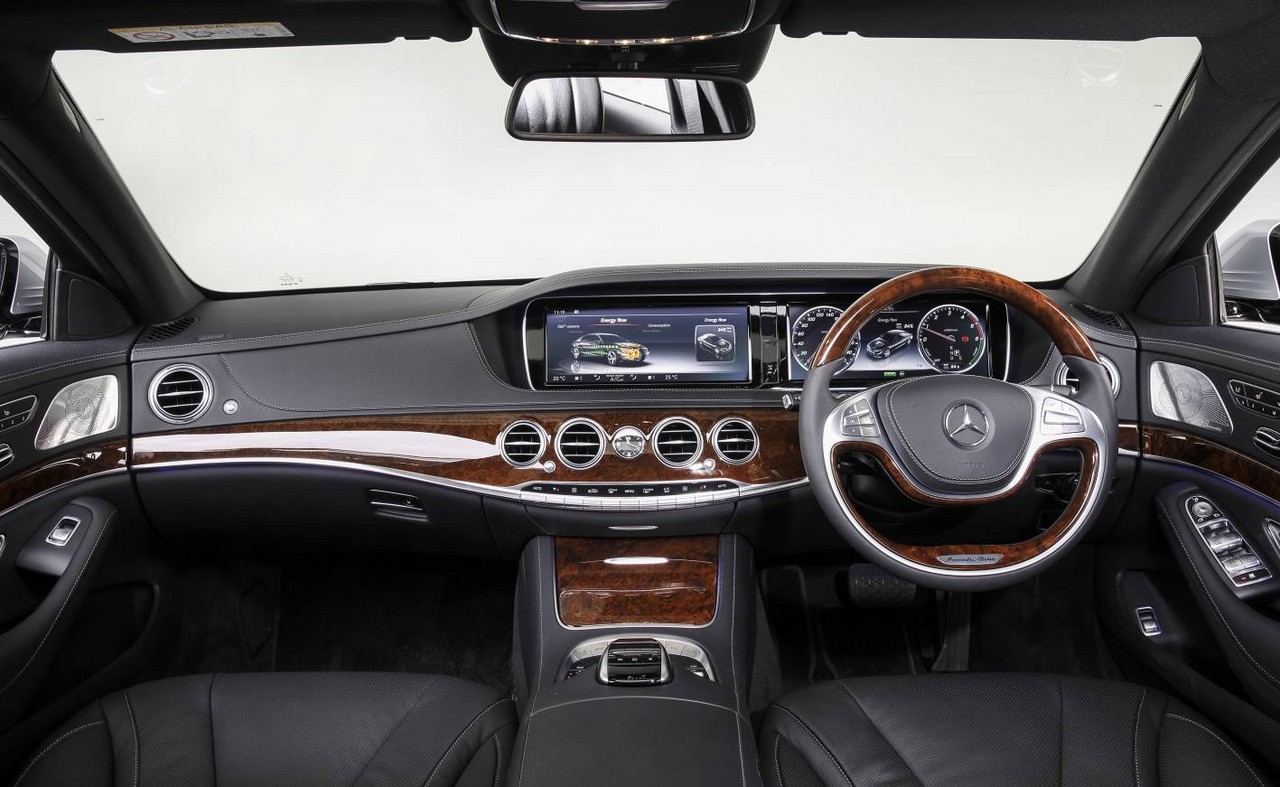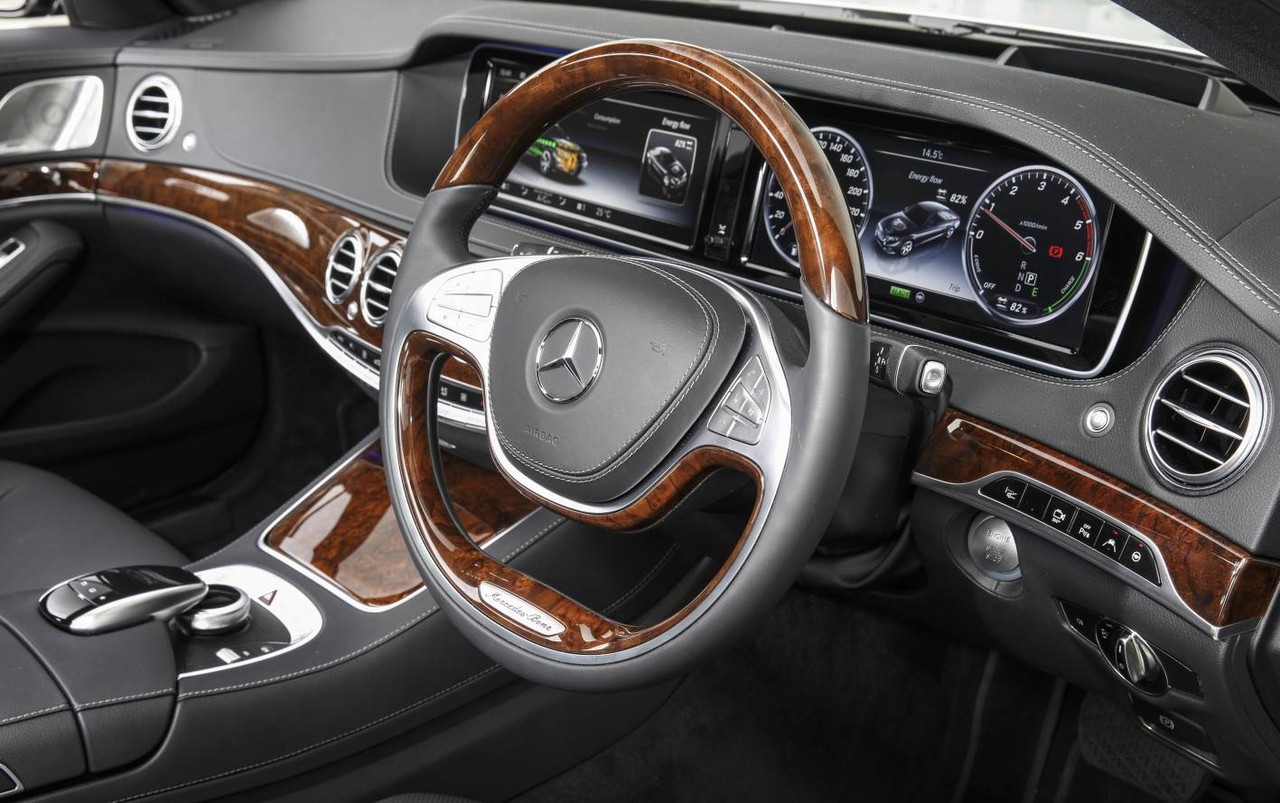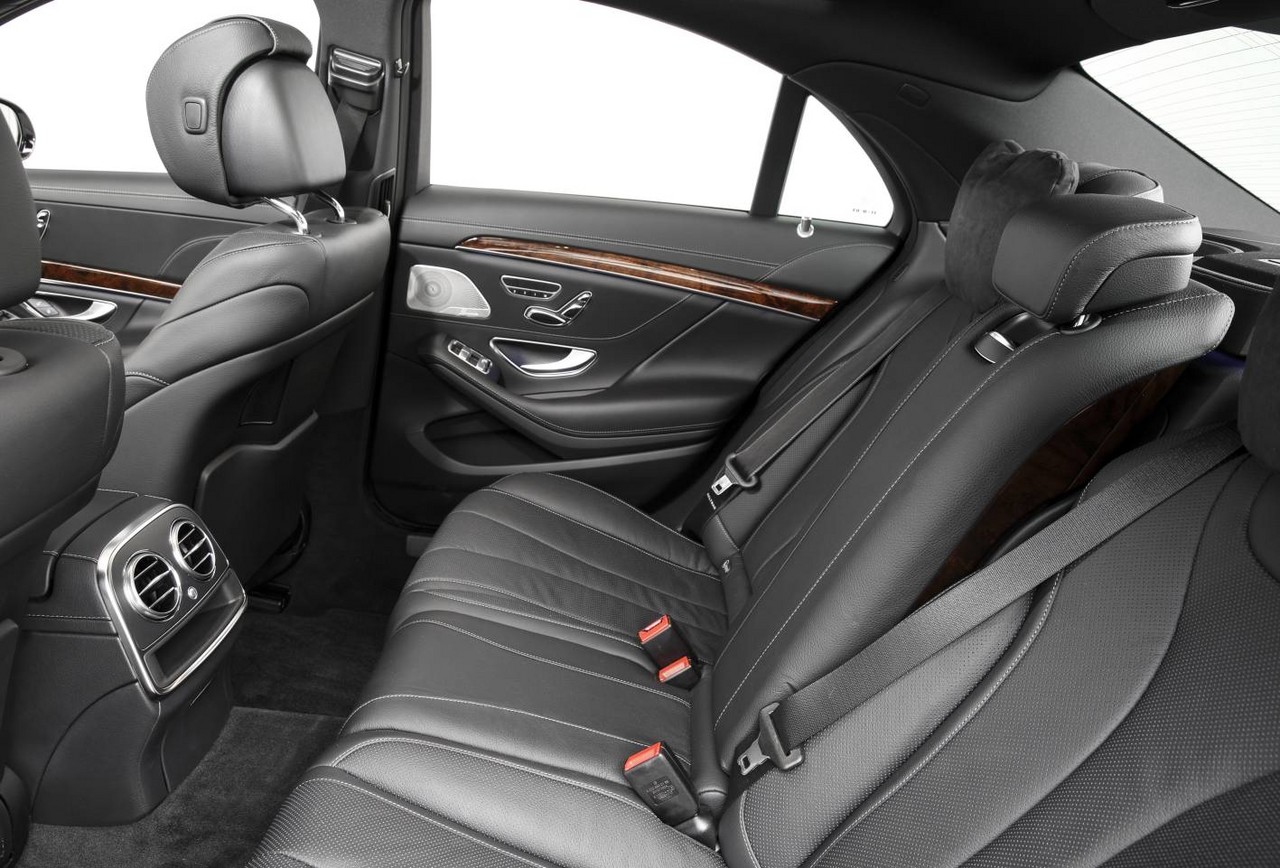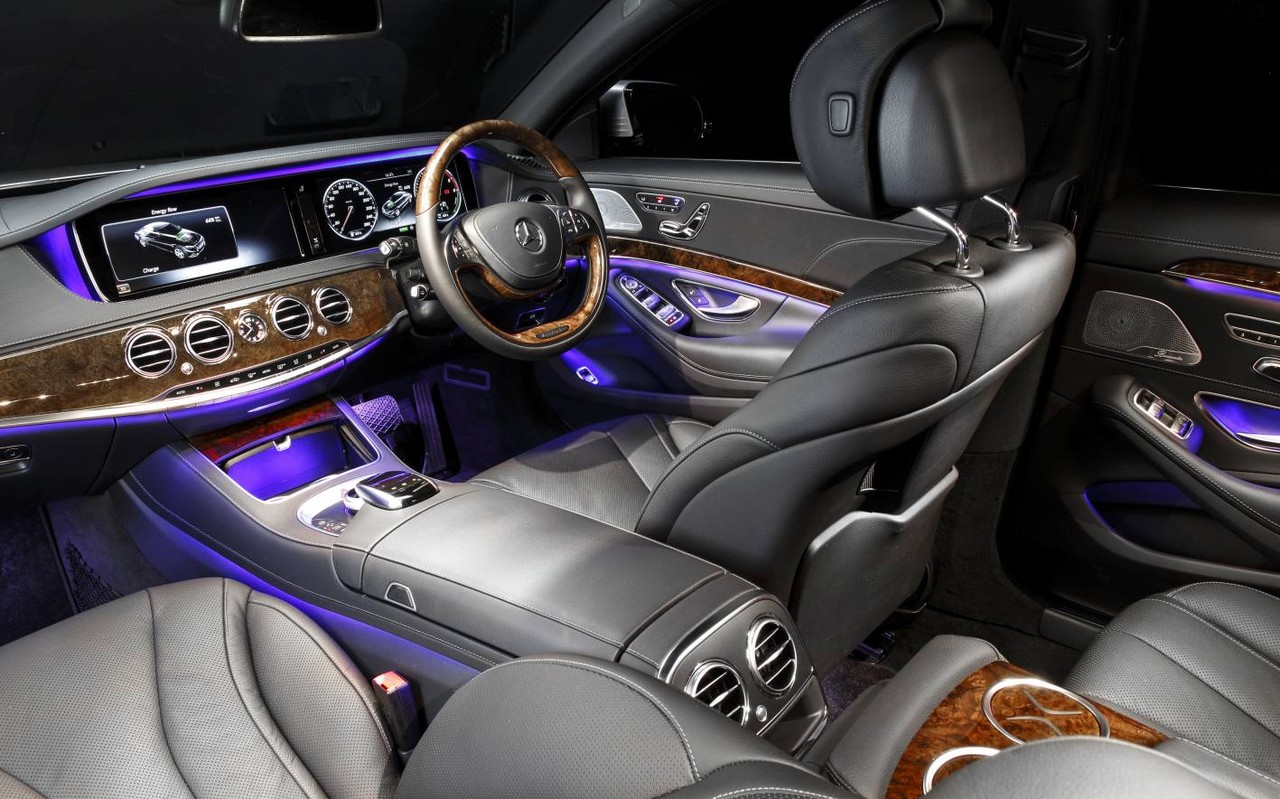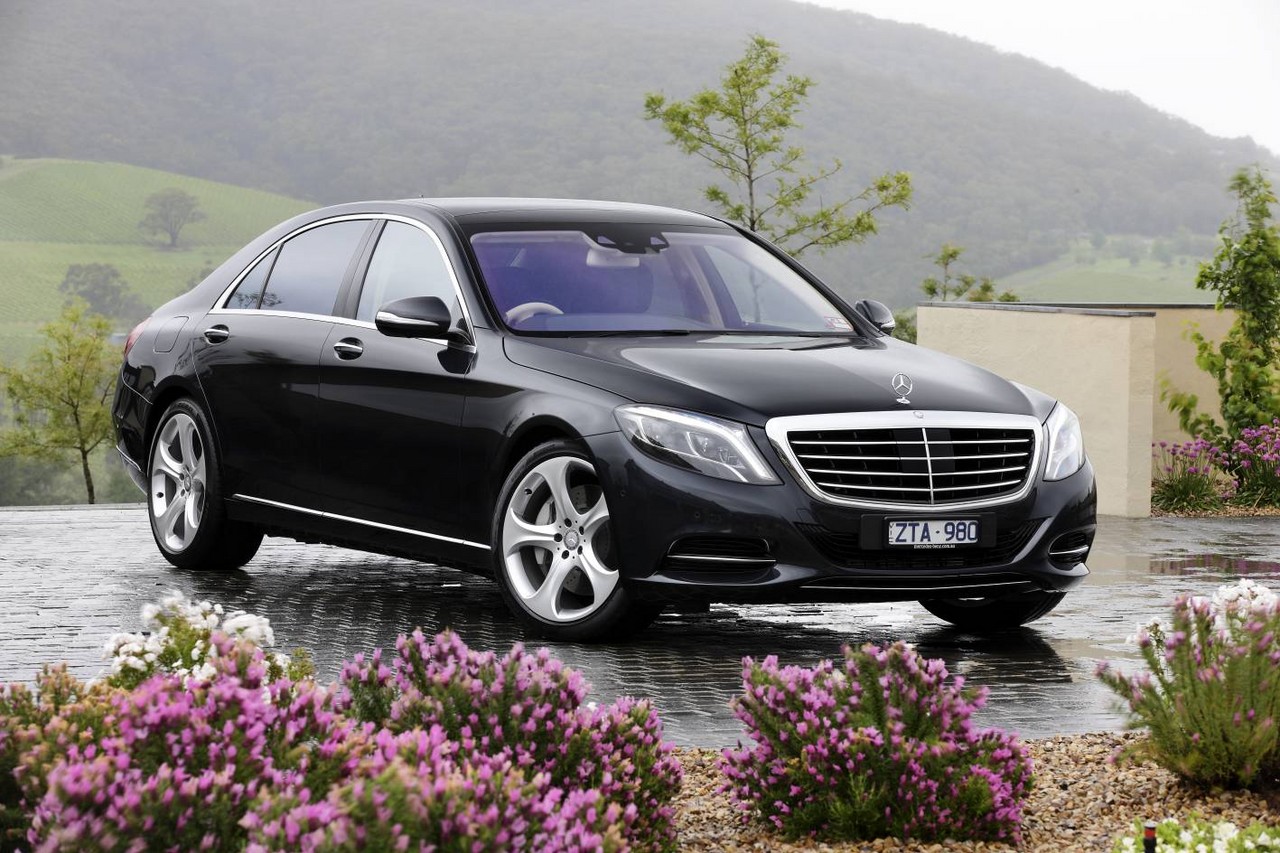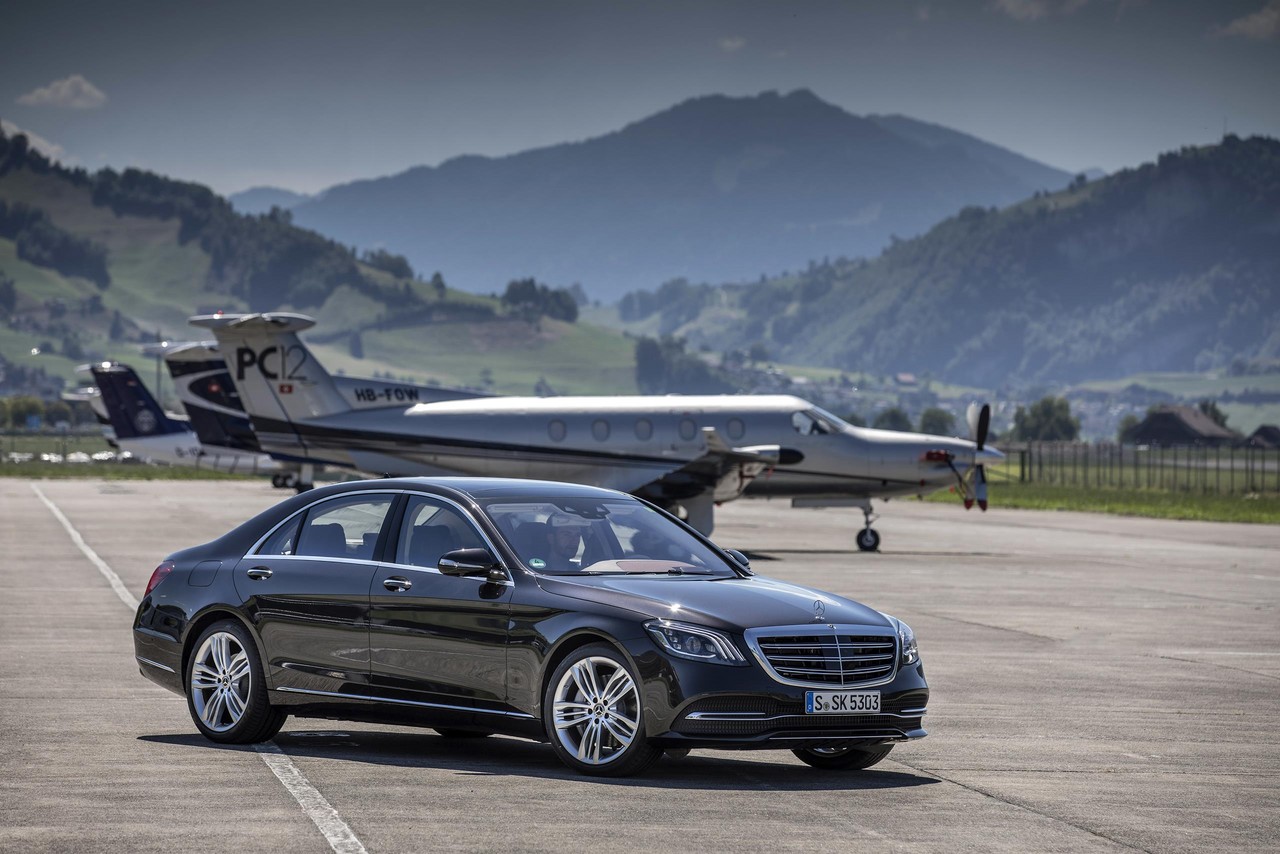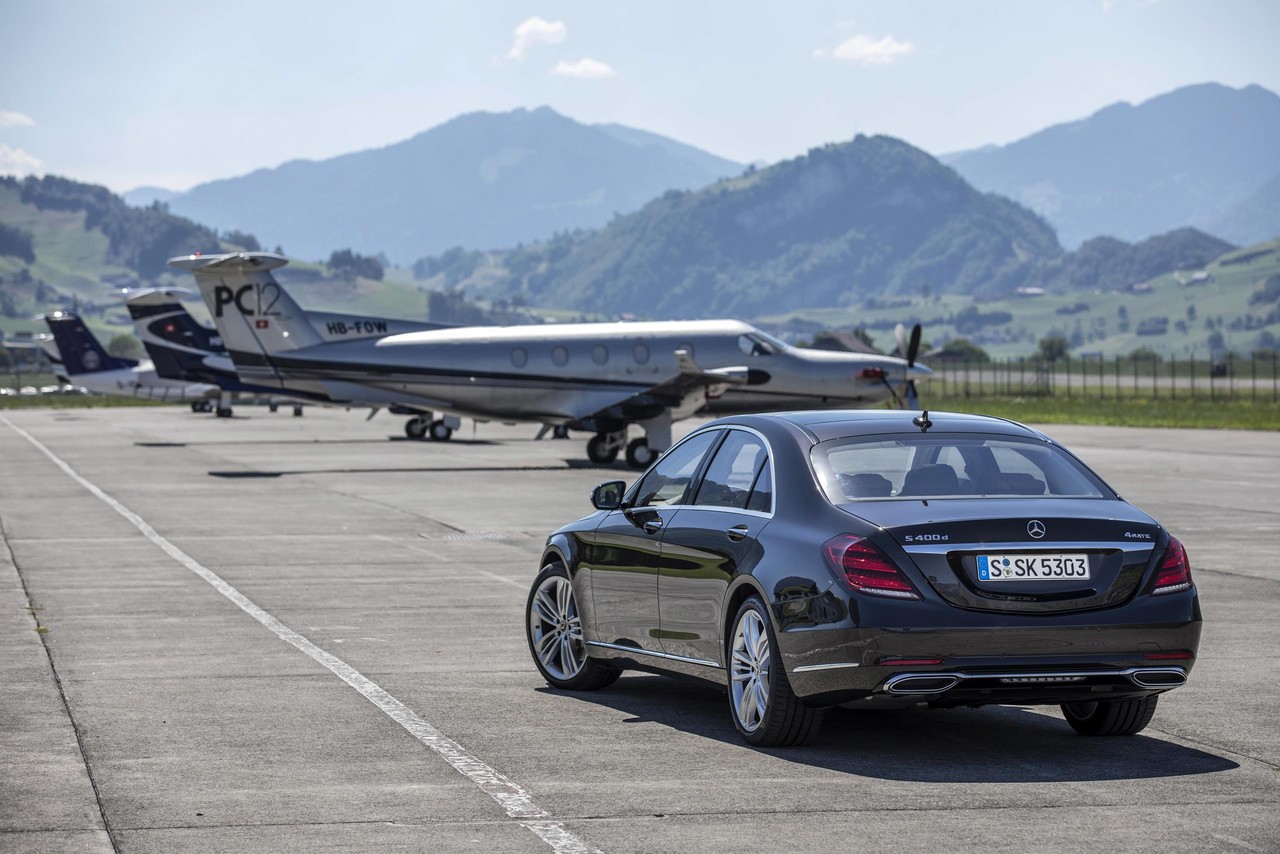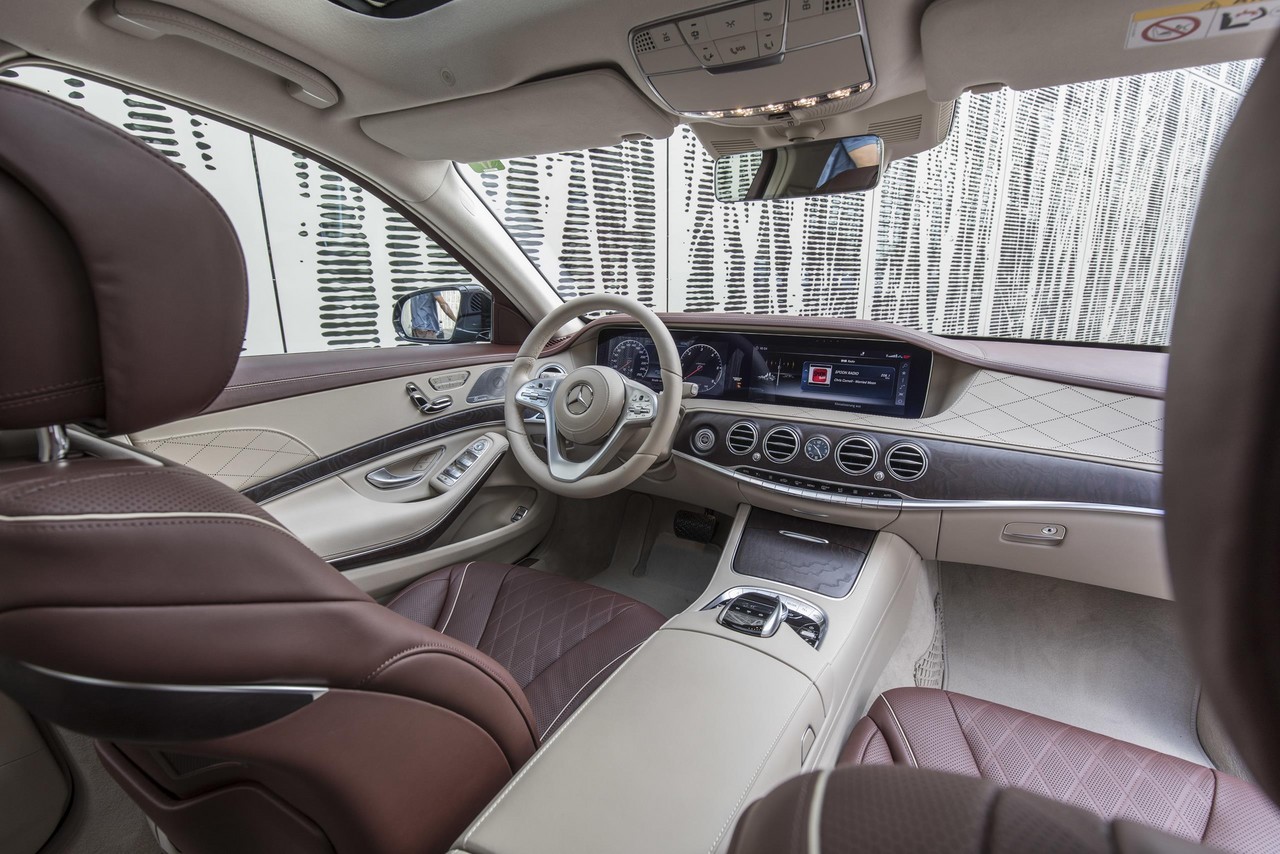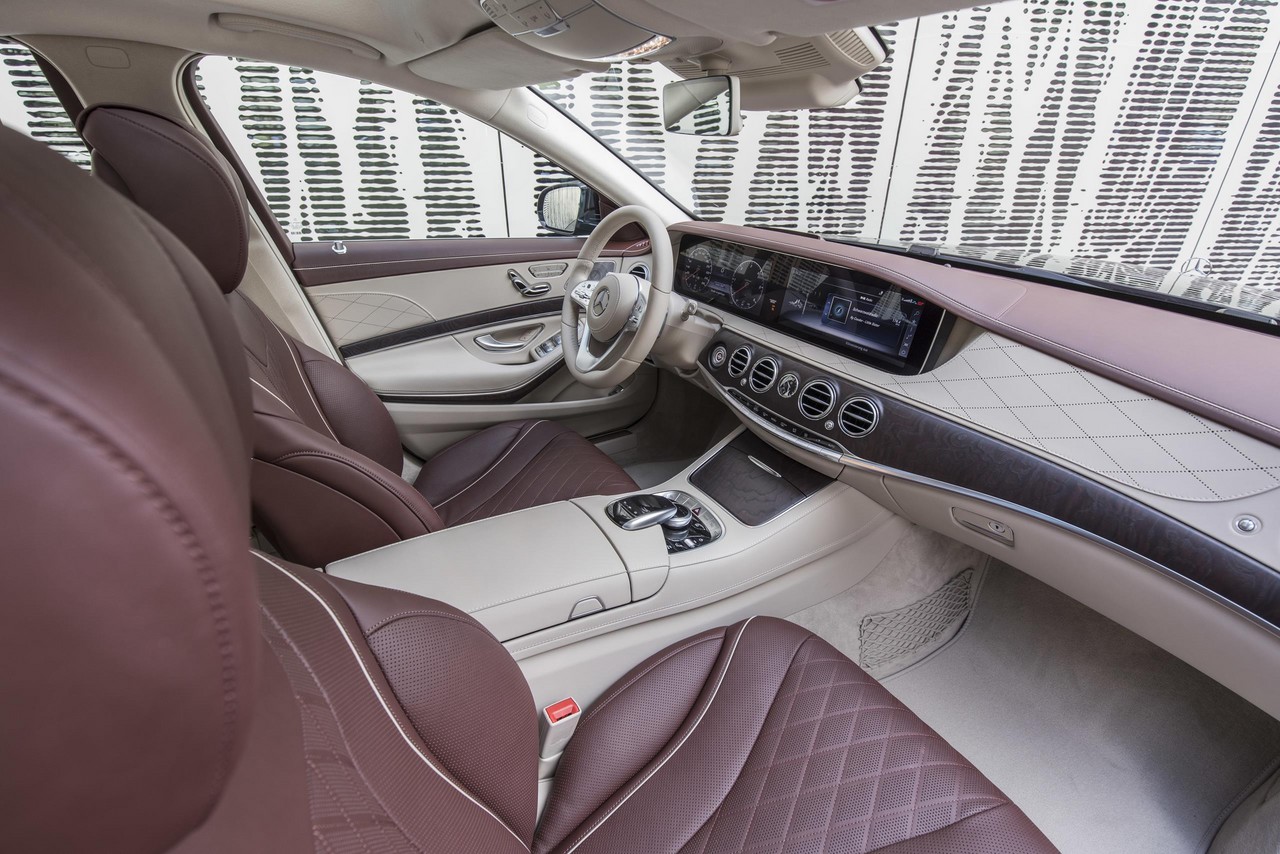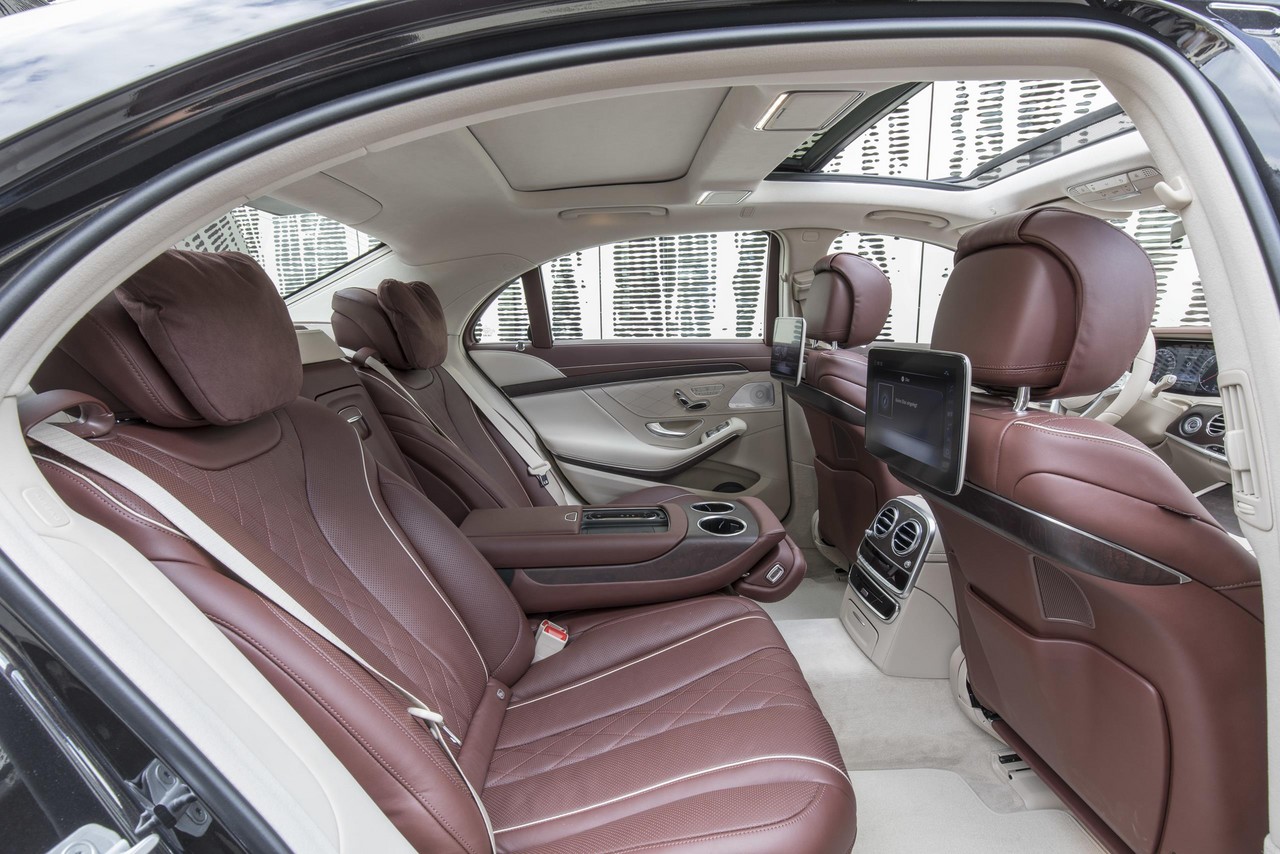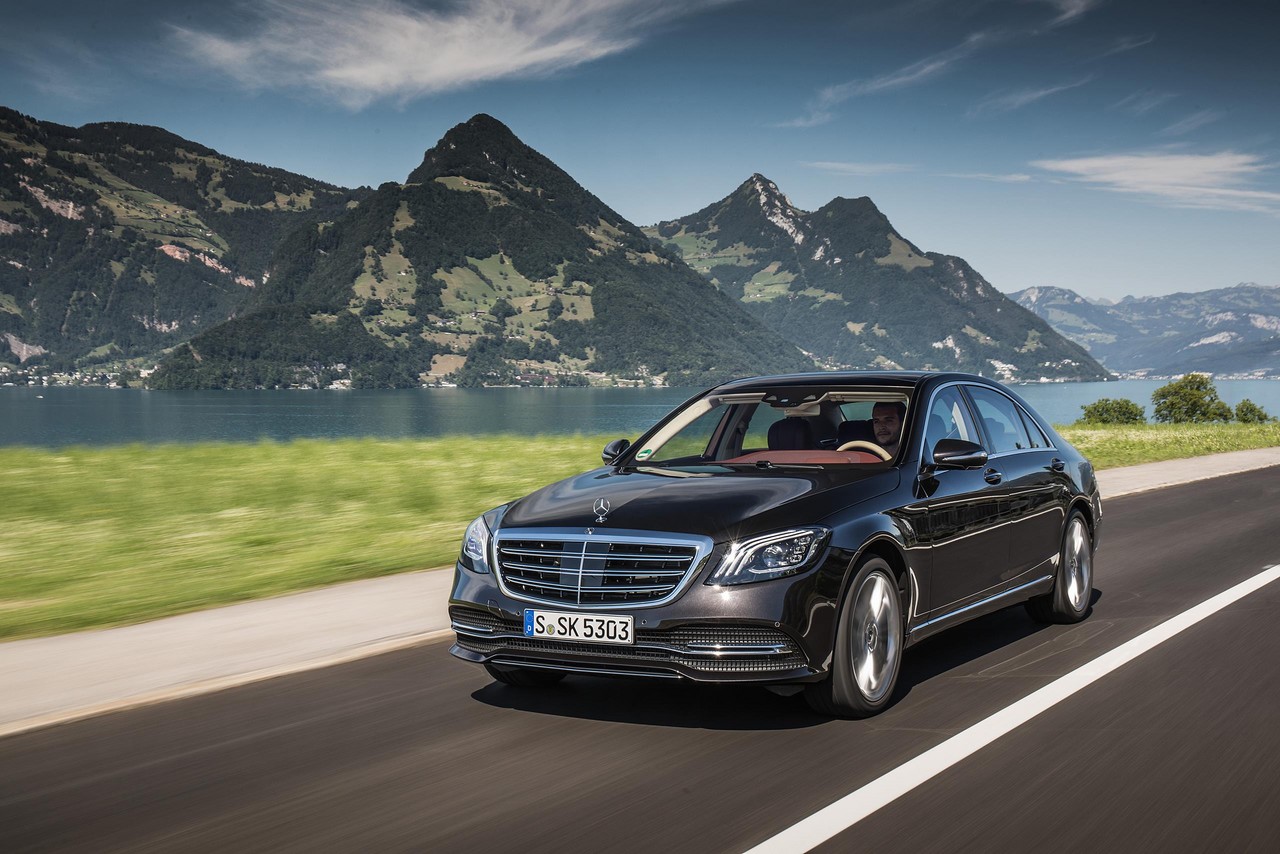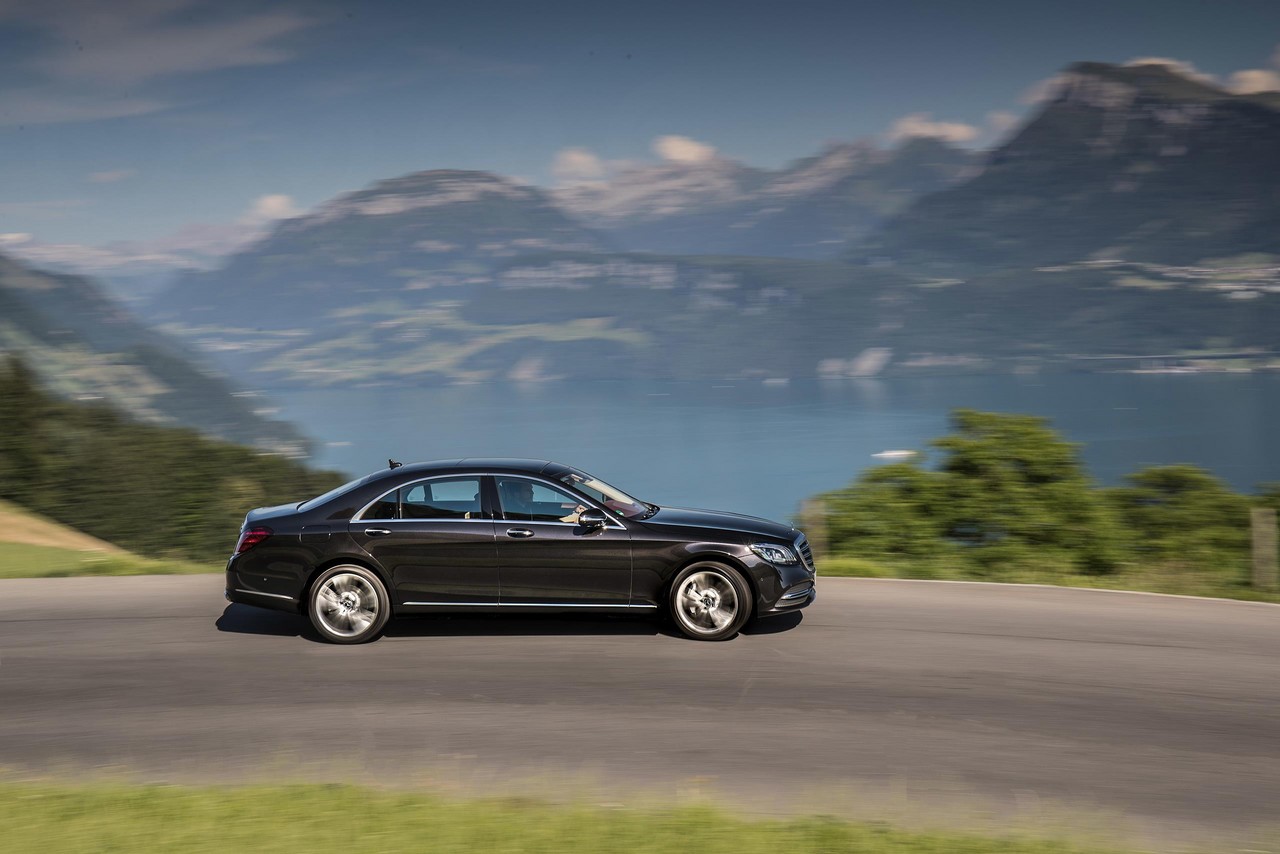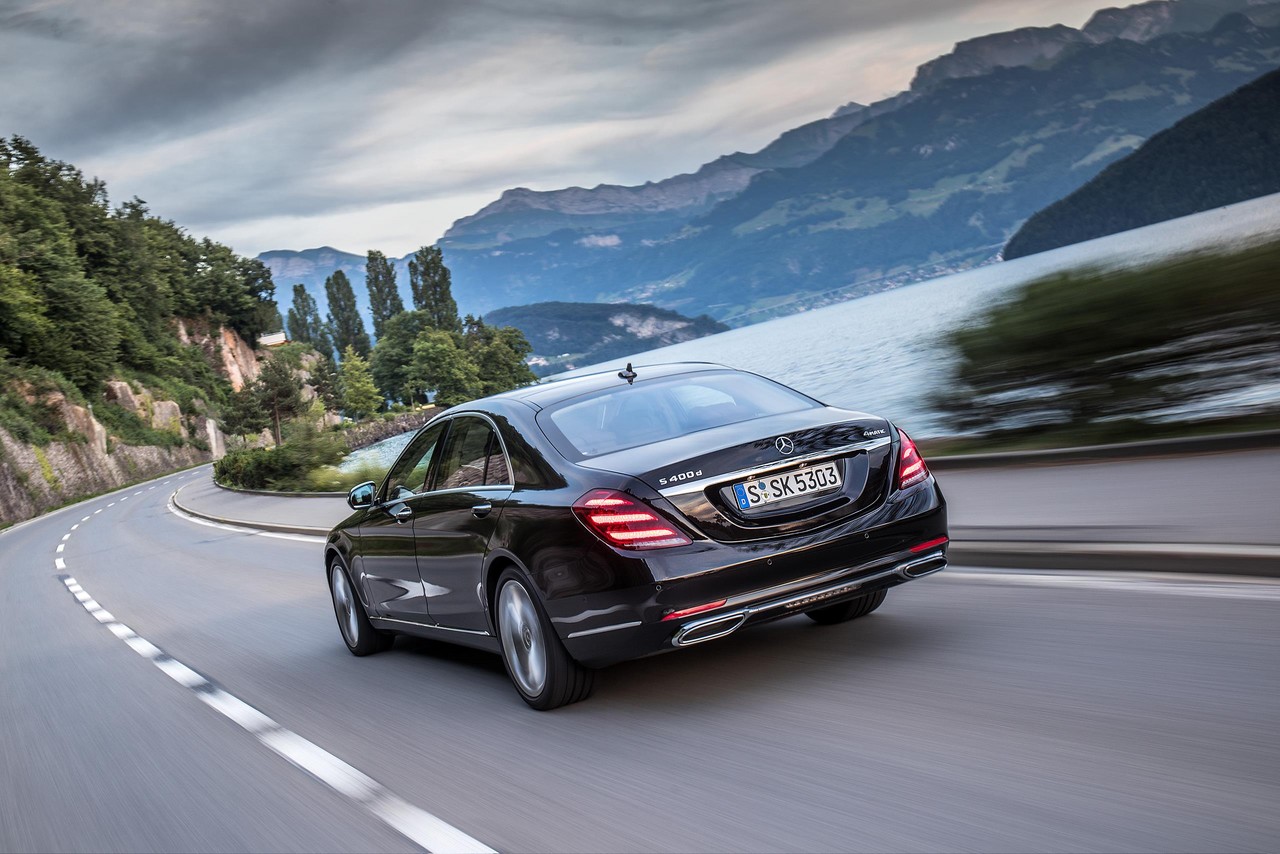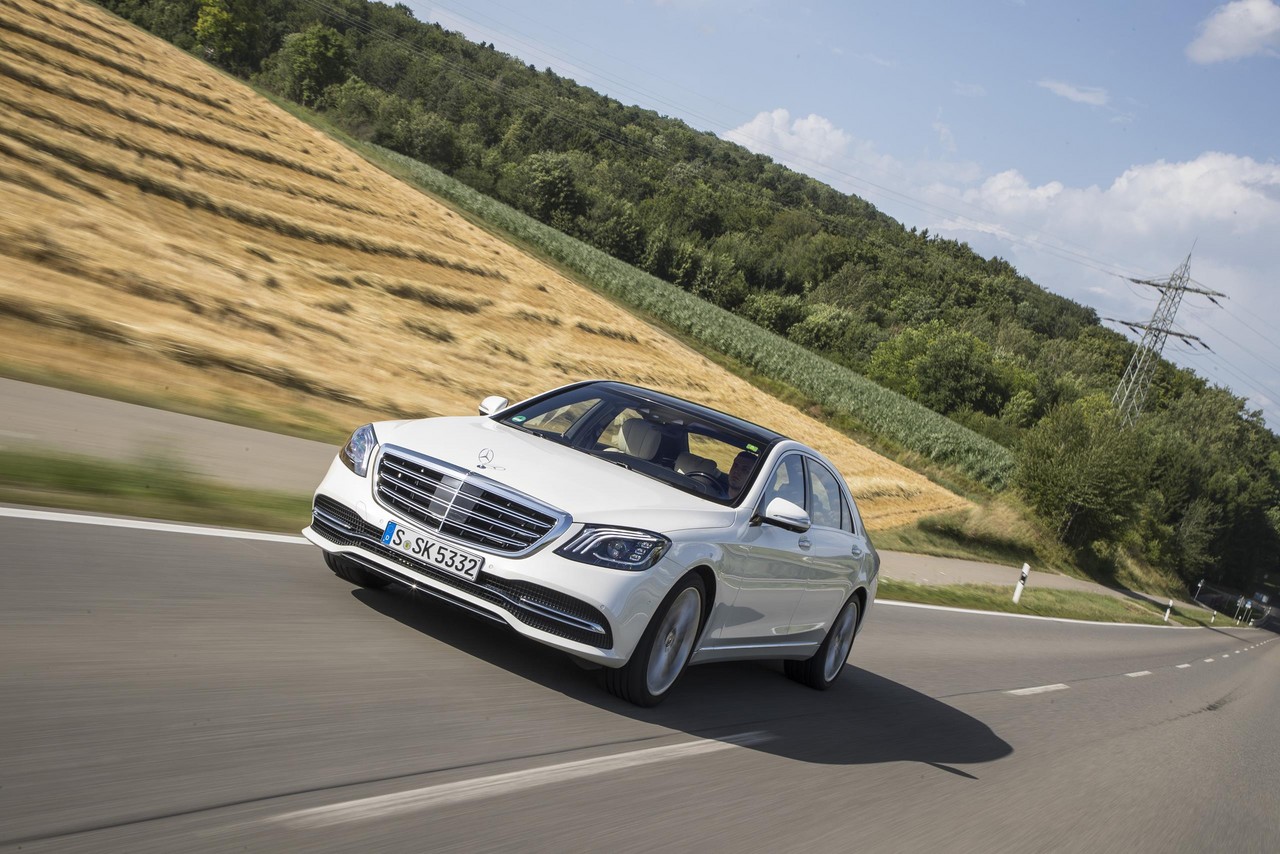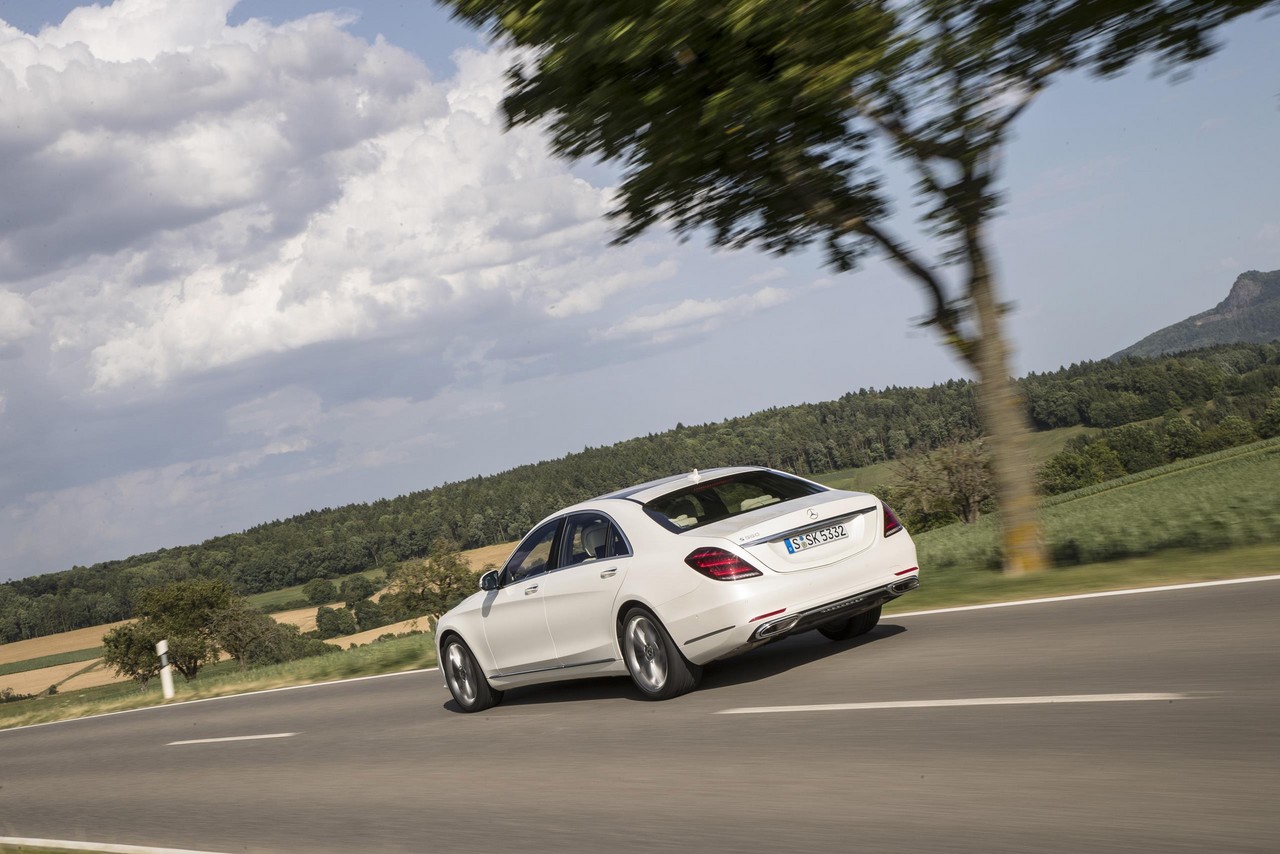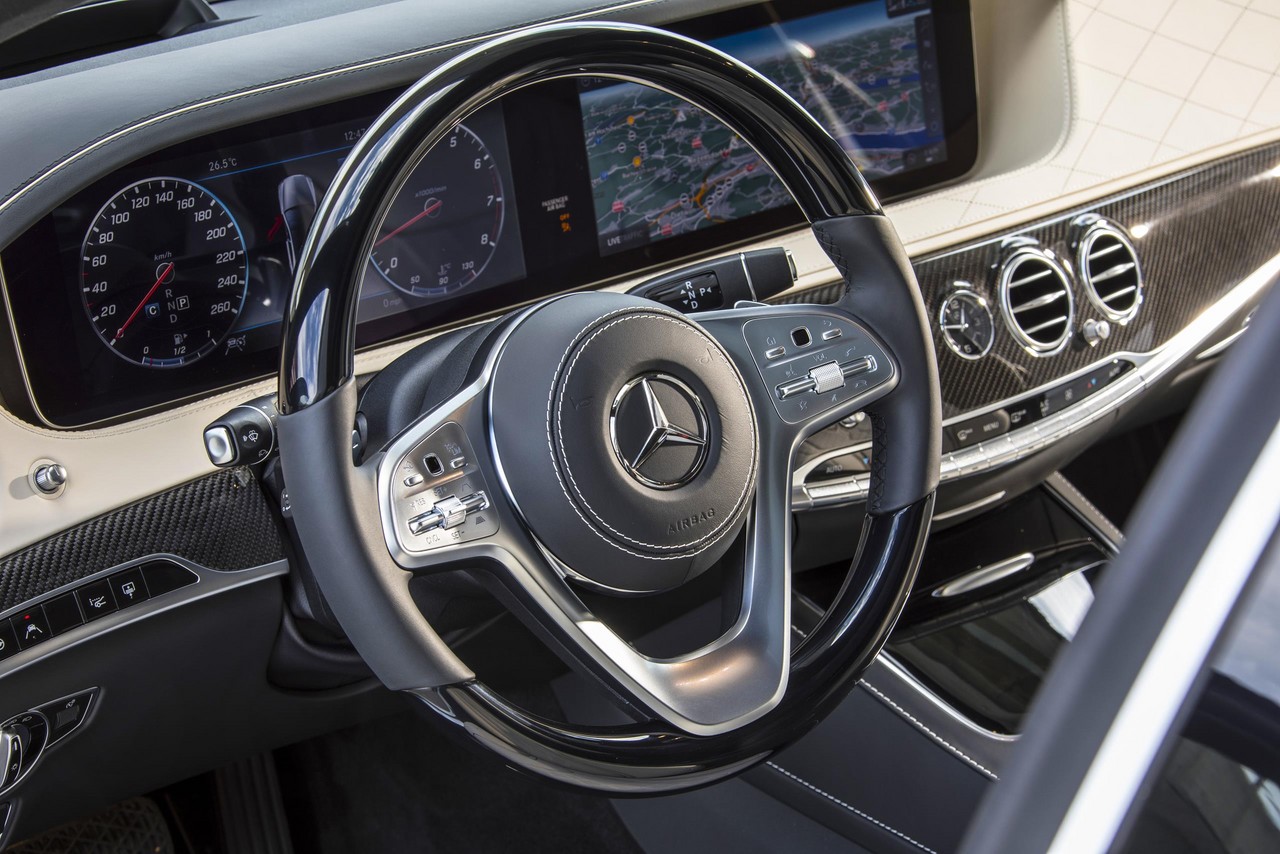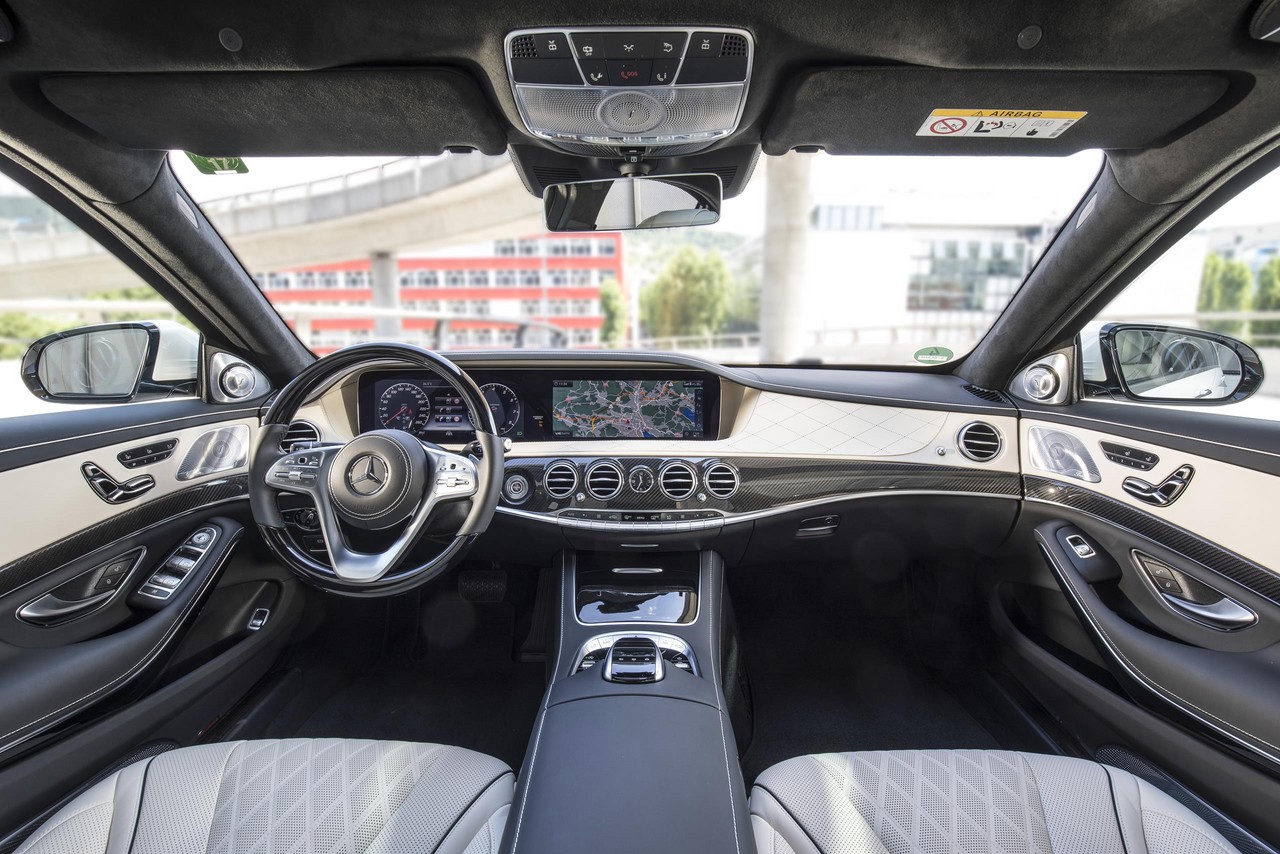
- Refined, fuel-efficient powertrains
- Excellent ride/handling balance
- Impressively quiet cabin has supremely comfortable seats
- High standard of interior fit and finish
- Where fitted, low profile tyres hurt ride quality
- Magic Ride Control doesn’t alway work as intended
- High running, depreciation and maintenance costs
Review: Mercedes-Benz W222.I/V222.I S-Class (2013-17)
Overview
Released in Australia in November 2013, the W222 and V222 S-Class were prestige sedans with standard and long wheelbases, respectively. Manufactured in Sindelfingen, Germany, the W222 S-Class range initially consisted of the S 350 BlueTec and S 500 models. The range, however, was subsequently expanded with the S 300 BlueTec Hybrid (June 2014), S 400 Hybrid (June 2014), S 600 (June 2014) and S 500 e (July 2016). A plug-in hybrid, the S 500 e had an official fuel consumption of 2.8 litres per 100 km over the combined ADR 81/02 test cycle and, according to Mercedes-Benz, had an all-electric range of up to 33 kilometres.
Please note that the Mercedes W222 S 63 AMG and S 65 AMG have been reviewed separately.
| W/b | Years | Engine | Trans. | Peak power | Peak torque | |
|---|---|---|---|---|---|---|
| S 300 BlueTec Hybrid | SWB, LWB |
2014-17 | 2.1-litre twin-turbo diesel I4 (OM651) | 7sp auto | 150 kW at 4200 rpm | 500 Nm at 1600-1800 rpm |
| Electric motor | 20 kW | 250 Nm | ||||
| S 350 BlueTEC | SWB, LWB |
2013-17 | 3.0-litre turbo-diesel V6 (OM642) | 7sp auto | 190 kW at 3600 rpm | 620 Nm at 1600-2400 rpm |
| S 400 Hybrid | LWB | 2014-17 | 3.5-litre petrol V6 (M276 DE35) | 7sp auto | 225 kW at 6500 rpm | 370 Nm at 3500-5250 rpm |
| Electric motor | 20 kW | 250 Nm | ||||
| S 500 | SWB, LWB |
2013-17 | 4.7-litre twin-turbo petrol V8 (M278 DE46 AL) | 7sp auto | 335 kW at 5250 rpm | 700 Nm at 1800-3500 rpm |
| S 500 e | LWB | 2016-17 | 3.5-litre petrol V6 (M276 DE35) | 7sp auto | 245 kW at 5250-6000 rpm | 480 Nm at 1600-4000 rpm |
| Electric motor | 85 kW at 3500 rpm | N/A | ||||
| Combined | 325 kW at 5250-5500 rpm | 650 Nm at 1000-4750 rpm | ||||
| S 600 | LWB | 2014-17 | 6.0-litre twin-turbo petrol V12 (M279 E60 AL) | 7sp auto | 390 kW at 4900-5300 rpm | 830 Nm at 1900-4000 rpm |
Body and dimensions
The Mercedes-Benz W222/V222 S-Class had a hybrid steel/aluminium body with the proportion of aluminium exceeding 50 per cent. Compared to its W221 predecessor, the W222 S-Class achieved a 47 per cent increase in torisonal rigidity (40.5 kN/degree versus 27.5 kN/degree). To minimise mass, the outer body panels of the W222 S-Class – including the roof and the front section of the body – were made from aluminium.
Compared to the Mercedes-Benz 221 S-Class , the standard wheelbase W222 S-Class was 40 mm longer (at 5116 mm), 28 mm wider (1899 mm) and 18 mm taller (1491 mm), though wheelbase length was unchanged (3035 mm). For the long wheelbase models, both wheelbase and overall length were extended by 130 mm. Furthermore, the W222 S-Class had a drag coefficient of 0.24 Cd (0.23 Cd for the S 300 BlueTEC).
Suspension
The Mercedes-Benz W222/V222 S-Class had four-link front suspension and multi-link independent rear suspension, both with air springs, monotube shock absorbers and anti-roll bars. For the W222 S-Class, the continuously adaptive damping function of the air springs – Mercedes-Benz’s ‘Airmatic’ system – was improved with new bellows, while rear axle spring travel was increased.
Models with eight cylinder engines were fitted with Mercedes-Benz’s ‘Active Body Control’ whereby the spring struts were fitted with hydraulic cylinders that could adjust the force in each spring strut individually, thereby compensating for body lift, roll and pitch. The S 600 L was also fitted with Mercedes-Benz’s ‘Magic Body Control’ used a stereo camera with a range of 15 metres (‘Road Surface Scan’) to detect bumps on the road ahead and use this information to prepare the suspension accordingly.
Safety equipment
Standard safety equipment for the Mercedes-Benz W222 and V222 S-Class included dual front airbags, front and rear side airbags, full-length curtain airbags, ABS, electronic brake force distribution, brake assist, electronic stability control, traction control and front and outer rear seatbelts with pre-tensioners and load limiters. Furthermore, the reclining rear seat – where fitted – had an airbag under the seat cushion (a ‘cushionbag’) to prevent submarining effects in the event of a collision.
In addition to the anticipatory ‘Pre-Safe’ safety measures (such as priming of the brakes in emergency situations, tensioning the seatbelts and closing the windows), Mercedes-Benz’s standard ‘Pre-Safe’ technologies for the W222/V222 S-Class also included:
- BAS Plus with Cross-Traffic Assist: used a 24 GHz radar sensor with a range of 30 metres and a 77 GHz radar sensor with a range of 200 metres to monitor the distance to the vehicle ahead and would warn the driver if there was a risk of a collision. Brake Assist Plus could detect vehicles when travelling at speeds up to 200 km/h, and stationary objects when the driver was travelling at 7 km/h to 72 km/h. Significantly, Brake Assist Plus could calculate the necessary brake force assistance to prevent a rear-end collision, build up that pressure in the braking system and provide it as soon as the brake pedal was depressed for ‘the best possible deceleration’. The Cross-Traffic Assist function could operate at speeds up to 72 km/h and used the stereo camera and radar sensors to detect traffic that was crossing in front of or behind the vehicle. If detected, the driver would receive visual and audible alerts;
- Pre-Safe Brake with pedestrian detection (autonomous emergency braking): using two 24 GHz sensors behind the front bumper which had a range of 30 metres and a 77 GHz radar which had a range of 200 metres, Pre-Safe Brake operated at speeds between 30 km/h and 200 km/h, and at speeds below 70 km/h if the vehicle was approaching a stationary queue of traffic. Around 2.6 seconds before the anticipated moment of impact, an audible warning would sound and a red warning would appear in the tachometer. Around 1.6 before the calculated impact, the first stage of Pre-Safe Brake would initiate partial braking autonomously with around 40 per cent of the maximum braking power (approximately four (4) m/s2); the Pre-Safe occupant protections system would also be activated. If the driver then applied the brakes, maximum braking force would be made available. If the driver failed to react, Pre-Safe Brake would – in its second stage – initiate autonomous emergency braking (i.e. maximum braking power) around 0.6 seconds before the unavoidable collision to reduce the severity of the impact. The pedestrian recognition function enabled Pre-Safe Brake to detect pedestrians when driving at speeds of up to 50 km/h;
- Pre-Safe Plus: could anticipate rear-end collisions and warn following traffic by flashing the rear hazard warning lights at high frequency; and,
- Pre-Safe Impulse: in the event of a collision, both front occupants would initially be pulled away from the direction of impact by their seat belts prior to the subsequent occupant deceleration (reducing the risk and severity of injuries in a frontal collision).
Further safety equipment – fitted as standard – included:
- Distronic Plus (adaptive cruise control with brake warning): an ‘adaptive’ cruise control system which used two short-range radar sensors positioned behind the front bumper to monitor the road up to 30 metres ahead, and a long-range radar located behind the radiator grille which had a range of 200 metres. Operating at speeds up to 200 km/h, Distronic Plus used an electronic control unit to analyse the information from both radar systems to calculate the engine, automatic transmission and braking parameters required for proximity control. As such, Distronic Plus could automatically apply the brakes to prevent the vehicle from becoming too close to traffic ahead (the time interval could be specified) and accelerate back to the set speed when traffic allowed. To accelerate from rest, the driver only needed to operate the Distronic stalk on the steering column or briefly depress the accelerator pedal. With Distronic Plus, automatic deceleration of up to four (4) m/s2was possible. If Distronic Plus detected that heavier braking was required, a warning light would illuminate in the instrument cluster and be accompanied by an audible warning. Furthermore, the electronic proximity control system could be activated independently of Distronic Plus at speeds over 30 km/h to alert the driver if they were approaching another vehicle too rapidly;
- Steering Assist with Stop&Go Pilot: operating in conjunction with Distronic Plus and at speeds up to 130 km/h, Steering Assist used a stereo camera located behind the windscreen to detect road markings, while the Stop&Go Pilot operated at speeds up to 60 km/h and enabled the system to use the vehicle in front or road markings as a means of orientation. If the vehicle was detected to be drifting out of its lane, Steering Assist would warn the driver and provide steering intervention to keep the vehicle in its lane;
- Active Blind Spot Assist: active at speeds above 60 km/h, a corrective braking force would be applied to the wheels on one side of the vehicle if the driver attempted to change lanes when a vehicle was detected in the driver’s blind spot;
- Active Lane Keeping Assist: would vibrate the steering wheel as the vehicle approached a continuous lane marking line and, if crossed, automatically brake wheels on one side of the vehicle to return the vehicle within the lane;
- Crosswind Assist: could detect sudden, strong gusts of wind and prevent the vehicle from drifting out of its lane via corrective braking forces on one side of the vehicle; and,
- Attention Assist with drowsiness detection: operated at speeds in excess of 80 km/h and assessed driver behaviour (including steering movements) for signs of drowsiness; if detected, the driver would be provided with visual and audible warnings.
The Mercedes-Benz V222 S 600 L was also fitted with Mercedes-Benz’s ‘Night View Assist Plus’ which could alert the driver to the hazards of pedestrians or animals in unlit areas ahead of the vehicle by automatically switching the instrument cluster from displaying the speedometer to an image generated by a thermal camera which highlighted hazards. Furthermore, a spotlight function could flash any pedestrians detected ahead to warn them of the vehicle’s approach.
Features: S 300 BlueTec Hybrid
Standard features for the S 300 BlueTec Hybrid included 18-inch alloy wheels, a ten speaker sound system, Mercedes-Benz’s COMAND system with a 31.2 cm high-resolution display, satellite navigation with 3D maps, integrated WLAN hotspot, ‘Linguatronic’ voice control, Bluetooth mobile phone connectivity and audio streaming, a CD/DVD player, auxiliary inputs (USB/iPod/SDHC), a 10 GB Media Register, dual-zone climate control air conditioning (‘Thermotronic’), cruise control with variable speed limiter (‘Speedtronic’), leather upholstery, power adjustable front seats, heated and ventilated front seats, automatic headlights, rain-sensing wipers, front and rear parking sensors, four cameras for 360 degree surround views, a nappa leather steering wheel with gearshift paddles, remote central locking, proximity key with push-button start (‘keyless go’), power windows, power adjustable and heated door mirrors with folding function, a power adjustable steering wheel (for height and reach), memory settings (for the front seats, steering wheel and door mirrors), a panoramic glass sunroof, ambient lighting, illuminated vanity mirrors, dark brown eucalyptus high-gloss wood trim, a trip computer and an immobiliser.
As standard, the S-Class was also fitted with Mercedes-Benz’s ‘Active Parking Assist’ system which could identify suitable parallel parking spaces – when traveling at speeds of up to 36 km/h – and autonomously steer the vehicle as the driver reversed towards the parking space.
Features: S 350 BlueTec and S 400 L
Compared to the S 300 BlueTec Hybrid, the S 350 BlueTec and S 400 L were further equipped with a 590 watt Burmester surround sound system with thirteen speakers, a nine channel digital sound processing (DSP) amplifier, digital radio (DAB+), DVB digital TV tuner and LED headlights with Mercedes-Benz’s ‘Intelligent Light System’.
The S 400 L was also fitted with 19-inch alloy wheels.
Features: S 500
Relative to the S 350 BlueTec, the S 500 added 20-inch five-spoke alloy wheels, a COMAND touchpad, a combination wood/leather steering wheel, brown burr walnut wood trim, laminated glass, a power closing function for the doors and an anti-theft protection package.
Features: S 350 BlueTec L, S 400 L, S 500 L
Compared to their standard length wheelbase counterparts, the long wheelbase (LWB) models were further equipped with four-zone climate control air conditioning, power adjustable rear seats (with memory settings), powered rear blinds, a power-operated rear windscreen roller blind and luxury rear head restraints with pillows.
The S 500 L was further equipped with ‘Easy Adjust’ luxury head restraints for the front occupants and a rear entertainment system.
Features: S 600 L
Compared to the S 500 L, the S 600 L was distinguished by its 19-inch alloy wheels, head-up display, a six-disc CD/DVD changer with ‘Splitview’ display function, exclusive nappa leather upholstery, multi-contour front seats, chauffeur position for the front passenger seat, multi-contour rear seats with heating and ventilation functions, convenience telephony, Dinamica sunvisors and roof lining, integrated garage door opener, brown burr walnut high gloss wood trim, and ‘Magic Vision Control’ which directed water onto the windscreen via channels in the windscreen wiper blades to keep the windscreen clean.
The S 600 L also featured an ‘Air-Balance’ package which provided perfume atomisation, ionisation and more efficient air filtration.
Brochures
- Brochure: Mercedes-Benz W222/V222 S-Class (December 2013)
- Brochure: Mercedes-Benz W222/V222 S-Class (May 2014)
Related links
- Press Kit: Mercedes-Benz W222/V222 S-Class (July 2013)
- Specifications: Mercedes-Benz W222/V222 S-Class (March 2014)
- Specifications: Mercedes-Benz W222/V222 S-Class (July 2014)
Review: Mercedes-Benz W222.II/V222.II S-Class (2017-20)
Overview
Production of the Mercedes-Benz W222.II and V222.II S-Class commenced in July 2017 and it was released in Australia in October 2017. Significantly, the W222.II/V222.II S-Class introduced three new engines:
- A 3.0-litre OM656 inline six-cylinder diesel engine for the S 350 d and S 400 d;
- A 3.0-litre M256 inline six-cylinder petrol engine for the S 450 and S 500 (the latter not offered in Australia). Designed for electrification, the M256 engine had a 48 volt electrical system to power the water pump, air-conditioning compressor and Integrated Starter-Alternator (ISG), thereby eliminating the need for a belt drive for these components. A 12 volt system, however, powered the lights, cockpit, infotainment and control units; and,
- The 4.0-litre M176 biturbo V8 petrol engine for the S 560.
A plug-in hybrid model – with an electric range of around 50 kilometres – is expected to follow in 2018.
Visually, the Mercedes-Benz W222.II and V222.II S-Class models could be identified by their new radiator grilles – the grilles for models with six- and eight-cylinder engines had three twin louvres and vertical strips with a high-gloss black finish. At the rear, the Mercedes-Benz W222.II and V222.II S-Class had ‘crystal-look’ tail lamps with LEDs and three horizontal pairs of fibre optics, and a redesigned lower bumper with integrated tailpipe trim.
Inside, the W222.II and V222.II S-Class featured two new high-resolution displays –each of which had 12.3-inch (diagonal) screens – that shared a glass cover. In another development, the steering wheel had touch-sensitive controls that responded to swiping motions (like a smartphone) and could be used to control the infotainment system.
| Engine | Trans. | Peak power | Peak torque | |
|---|---|---|---|---|
| S 350 d | 3.0-litre OM656 turbo diesel I6 | 9sp auto | 210 kW at 3400-4600 rpm | 600 Nm at 1200-3200 rpm |
| S 400 d L | 3.0-litre OM656 turbo diesel I6 | 9sp auto | 250 kW at 3600-4400 rpm | 700 Nm at 1200-3200 rpm |
| S 450 L | 3.0-litre M256 biturbo petrol I6 | 9sp auto | 270 kW at 5500-6100 rpm | 500 Nm at 1600-4000 rpm |
| S 560, S 560 L |
4.0-litre M176 biturbo petrol V8 | 7sp auto | 345 kW at 5250-5500 rpm | 700 Nm at 2000-4000 rpm |
Suspension
For the W222.II and V222.II S-Class, the ‘Road Surface Scan’ system was improved by using the stereo camera system to scan the road more thoroughly, even in dusk and at speeds up to 180 km/h.
Previously introduced in the Mercedes-Benz C217 S-Class Coupe , the ‘Magic Body Control’ suspension had a curve-tilting function that could tilt the body of the vehicle towards inside of a turn by up to 2.65 degrees to reduce centrifugal forces perceived by the passengers. Active at speeds from 15 km/h to 180 km/h, the curve tilting function shifted the base point of each individual strut to allow the vehicle to incline.
Safety technologies
Fitted as standard for Australian-delivered W222.II and V222.II S-Class vehicles, ‘Distronic Active Proximity Assist’ made use of map and navigation data to monitor driving behaviour and adjust vehicle speed. Other standard safety technologies included –
- Active Emergency Stop Assist: could bring the vehicle to rest when Active Steer Assist was engaged and the system recognised that the driver was not intervening in the driving process on a sustained basis; and,
- Active Lane Change: tapping the indicator stalk could initiate a lane change within ten seconds provided that vehicles were not detected in the relevant safety zone.
Features
New features for the Mercedes-Benz W222.II and V222.II S-Class include –
- New Multi-beam LED headlamps with Ultra Range High Beam (the latter provides brightness in the main beams above the reference value of 1 lux over a distance of more than 650 metres);
- Apple CarPlay and Android Auto smartphone integration for the COMAND Online infotainment system; and,
- Wireless charging for mobile devices.
For the Mercedes-Benz S 560 and S 560 L, ‘Energizing comfort control’ integrated various comfort systems in the vehicle – such as climate control, ambient lighting, massage and fragrancing functions – so that customers could configure settings for six program names: Freshness, Warmth, Vitality, Joy, Comfort and Training.
For a complete list of features for the Mercedes-Benz W222.II and V222.II S-Class, please refer to ‘Specifications’, below.
Specifications
Related links
- Press Kit: Mercedes-Benz W222/V222 S-Class (July 2017)
- Mercedes-Benz Australia: Mercedes-Benz S-Class
- Wikipedia.org: Mercedes-Benz W222/V222 S-Class
